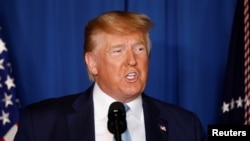For almost two years, the United States has pursued a policy of maximum pressure on the Iranian regime to reinforce to Iran’s leaders the need to follow international norms of peaceful coexistence. That strategy has clear economic and diplomatic components, including sanctions. Now, with the targeted killing on January 3 of one of the world’s most deadly terrorists, IRGC Qods Force commander Qassem Soleimani, the military component of the strategy is on display.
After months of restraint in the face of growing Iranian aggression in the region, including the shooting down of a U.S. drone over international waters and the bombing of the world’s largest crude oil processing facility in Saudi Arabia, the United States took decisive defensive military action.
The U.S. drone strike which killed Qassem Soleimani was authorized by President Donald Trump days after an American civilian defense contractor was killed and four American service personnel were injured by the Qods-backed terrorist group Kata’ib Hezbollah, and after Iranian-supported militias violently stormed the U.S embassy in Baghdad.
U.S. officials, including Secretary of State Mike Pompeo, declared that Soleimani was plotting further imminent attacks on American diplomats and military personnel. President Trump said that U.S. policy is “unambiguous to terrorists who harm or intend to harm any American:”
“We will find you; we will eliminate you; we will always protect our diplomats, service members, all Americans and our allies.”
As President Trump pointed out, for years under Soleimani’s leadership, the Revolutionary Guard Corps and the Qods Force injured and murdered hundreds of American service personnel and perpetrated countless acts of terror to destabilize the region:
“Just recently, Soleimani led the brutal repression of protesters in Iran, where more than a thousand innocent civilians were tortured and killed by their own government. We took action last night to stop a war; we did not take action to start a war.”
President Trump declared that the United States does not seek regime change in Iran:
“However, the Iranian regime’s aggression in the region, including the use of proxy fighters to destabilize its neighbors must end, and it must end now.”
“The future,” President Trump stated, “belongs to the people of Iran, those who seek peaceful coexistence and cooperation, not the terrorist warlords who plunder their nation to finance bloodshed abroad.”














